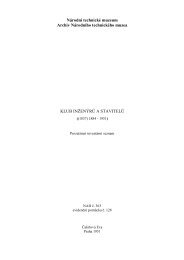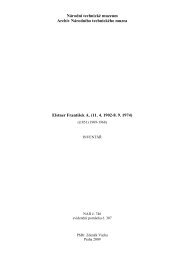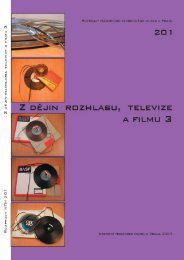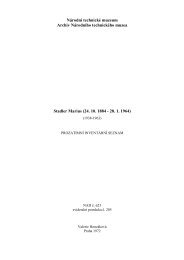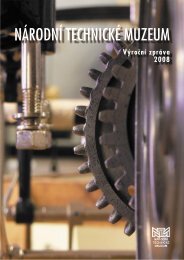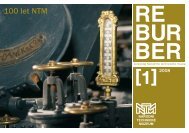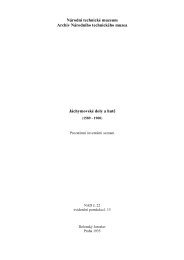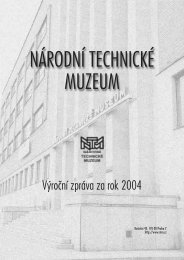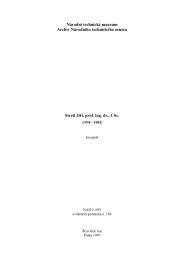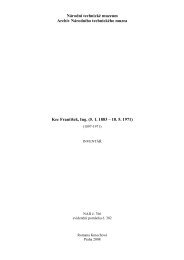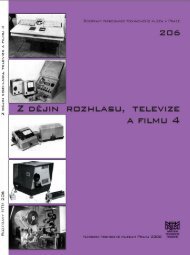VýroÄnà zpráva 2006 - Národnà technické muzeum
VýroÄnà zpráva 2006 - Národnà technické muzeum
VýroÄnà zpráva 2006 - Národnà technické muzeum
Create successful ePaper yourself
Turn your PDF publications into a flip-book with our unique Google optimized e-Paper software.
RefrigeratorCollection: Household TechnologyWooden single-wing refrigerator lined with zinc plate, which comes from the first half of the 20 th century. The ice is placed in the side part through the rectangular opening at the top of therefrigerator. At the bottom of this area is a tap for draining off melted ice. Manufacturer: B. Skalický, Vodňany. Dimensions: 700 x 550 x 840 mmThis basic classical wooden ice-filled refrigerator marks the beginning of development of refrigeration technology in the home. There is not yet any similar collection item in the Museum’scollection stock.CompassCollection: SurveyingHanging miner’s compass from the 19 th century without any indication of the manufacturer. Similar devices were frequently used from as early as medieval times in mines and underground.This is essentially the only instrument that makes it possible to measure the direction of a gallery even under poor lighting conditions. Even today, speleological maps of caves that have pooraccess are surveyed in a similar manner. The device is suspended using hooks on a cord extended in the direction of the gallery being measured and the compass rights itself horizontally.It is sufficient only to read the angles on the dial between the stretched cord and the magnetic needle pointing north. Sometimes the miner’s compass was adjusted so that the slope of thegallery could also be measured.Other purchases (only the more important acquisitions are mentioned here).The technology in the home collection stock was supplemented by a STELLA electrical drum washing machine, manufacturer Fr. Křižík, kabelovna a elektrotechnické závody a.s. (Cable Plantand Electrical Engineering Works joint stock company). The washing machine has a semi-cylindrical copper container, in which a copper drum rotates, fitted both with openings for water toflow into the drum and fins which turn and tumble the laundry. The copper container in which the laundry is washed is fitted with an outlet tap at the bottom and has double walls fitted withheat insulation which maintains the water temperature. The whole washing machine is on castor wheels. Dimensions 820 x 620 x 950 mm.The STELLA washing machine is an item which we have been trying to acquire for the collection for many years now. Both its mechanism and the fact that the washing machine was made bya domestic firm, that of Fr. Křižík, make it a major contribution to the collection.The electrical engineering collections were extended with a TESLA 1123A “Prelúdium Stereo” musical box, a radio-gramophone on a stand which combines a radio set derived from theStereodirigent type (identification no. 34 596 in the NTM) and a four-speed gramophone (HC11 chassis). This is a 6 + 2 electron tube set for all the usual wavelengths (VKV OIRT). Toreceive stereophonic broadcasting, the set is fitted with semi-conductors provided with a TSD3A stereodecoder. Components of this collection item are two twin-band speakers (66 838/b,c).Dimensions: 265 x 350 x 360 mm. The device is well preserved.Additions to the physics collection are meteorological apparatus (a psychrometer and an anemometer) and a set of dosimeters and a spherometer. We regard measuring instruments fromthe J. and J. Frič workshop from the end of the 19 th and the beginning of the 20 th century as important acquisitions too. The Frič brothers’ firm was one of the best here in the precisionengineering and optics field. We also succeeded in adding instruments to the microscope collection made by the Viennese company Reichert from around 1900 and the Prague workshop ofSrb and Štys, which was the predecessor of Meopta. The following items were added to the physics collection:Industrial design was enriched by a remarkable design for an Innotrac farm tractor.Hailed as the most important addition to the architecture collection is a unique set of bricklayer’s templates (a total of 131) and other items (outdoor plaster medallions) from the estate ofthe builder J. Ruprecht from the end of the 19 th and the beginning of the 20 th century.The cinematic photography collection purchased among other items in <strong>2006</strong> two viewfinder cameras for 35mm cinematic film – a Leica M4 and a Leica MD.Railway MuseumThe National Technical Museum’s Railway Museum was very active during <strong>2006</strong>. A “Railway Museum in the Czech Republic Concept” was prepared. The main operational task was spatialconcentration of the hitherto scattered collection in the new depository service area for historic rolling stock on the site of the former engine depot in Chomutov (altogether nearly 1 km ofcovered tracks), which will fully meet NTM requirements including certain spare room for future years.In connection with the “Concept” referred to, an acquisition plan was prepared for the Railway Museum. It is conceived as an open-ended document. Based on this, a list of specific itemswas successfully drawn up and acquisition negotiations begun with their owners. Quantitatively most important is the collection of historic rolling stock owned by ČD a.s., (Czech Rail), whichconsists of ca. 70 vehicles. Acquisition was negotiated with the management of Czech Rail and physical take overs were started.Acquisition activity did not only focus on vehicles but also on other items with a material connection to railways – as examples we can allude to a water tank crane from the Duchcov– Podmokly line or the oldest traction line poles from 1927.During <strong>2006</strong>, two important restoration successes were achieved – restoration of steam motor vehicleof steam engine 534.027.M 124.001 “Komarek” and completion of the second phase (of three) of restorationA different area of activity is creation of our own exhibition projects. First and foremost was thorough evaluation of the exhibition potential of the collection and consideration of the actualspace requirements for the railway museum field. Also the suitability of the selection of ca. 30 areas as an upper figure and 10 as a lower one for the railway museum’s requirements wasassessed. At the present time, in addition to the depository base in Chomutov referred to, two basic sites were reviewed - the main railway station in Olomouc and the North-West Stationin Děčín-East. Sites are selected both with regard to their particularly suitable individual features and also so that they do not compete with each other or with themselves, or the only siteoriginally considered in Prague – the Masarykovo Station (the former workshop). With regard to the project on this site it was stated that on the one hand it falls a long way short of meetingthe requirements on its own and also that the procedure for its preparation needs to be analysed critically. Currently continuation of its preparation is conditional upon establishing a conceptfor the overall transport and urban design solution for that particular part of central Prague in its target condition. In the area of long-term horizontal relationships the most important stepsare conclusion of a “Partnership Agreement” with Správa železniční dopravní cesty s.o. (Rail Track Administration) and Severočeské doly - Doprava a.s. (North Bohemia Mines Transport).An important specific success was achieved in the activity of the NTM’s Railway Museum in the area of care for historical railway architecture, which was restoration of the cladding on thehistoric station building in Děčín. This was done in direct cooperation with České dráhy a.s. (Czech Rail), the contractor and the NTM, which provided specialist supervision, and the result is abuilding which looked vulgar after unsuitable reconstruction in the 1970s but is one of the city’s attractions again today.46



